Rookie Retrospective, Kevin Love
Rookie Retrospective, Brook Lopez
Rookie Retrospective, Greg Oden
Rookie Retrospective, Russell Westbrook
Rookie Retrospective, D.J. Augustin
Rookie Retrospective, O.J. Mayo
Rookie Retrospective, Michael Beasley
Rookie Retrospective, Derrick Rose
Rookie Retrospective: Eric Gordon
SG 63 ¼ in shoes, 69 wingspan 222 Los Angeles Clippers
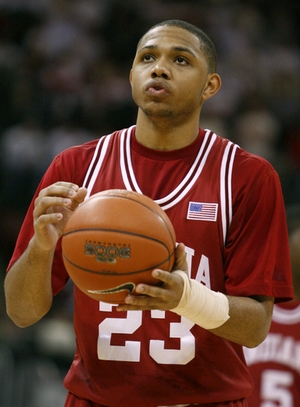
Part One: Perimeter Scoring & Shooting
Then:
"Shooting is probably Gordons biggest strength at the moment, showing a beautiful stroke, with a quick release, NBA range and a terrific follow through. He has a knack like few others in college basketball for setting his feet and squaring his shoulders as soon as he catches the ball, meaning hes always ready to shoot the ball, and hes surely always willing, due to the supreme confidence he has in his shooting ability. Gordon can hit shots coming off a screen or pulling up off the dribble, fading away and with a man in his face. His shot-selection isnt always the best, but he has a go-to scoring mentality (and ability), which is something that NBA scouts love to see, especially in a player this young."
- NCAA Weekly Performers, Part Two - 2/14/08
"Its been a very difficult February and March for Eric Gordon, as hes struggled badly with his shooting, hitting just 16 of his last 77 (21%) 3-pointers in his last 12 games. That slump did not magically snap as he went up against a tough Arkansas squad, and Gordons terrible shooting continued, hitting 3-15 from the field and 0-6 from behind the arc."
- Bad News for Those Who Didnt Do Their Homework Early... - 3/26/08
Now:
An rather streaky shooter at Indiana, Gordon became a reliable scoring option for the Clippers about three months into his rookie campaign. Since the start of 2009, hes averaged 19.8 PPG and has played just over 38 MPG, compared to just 10.4 PPG and 28.1 MPG before the New Year. His quick climb up the Clipper depth chart was assisted by a number of injuries to his teammates.
During his tenure in Bloomington, Gordon proved his worth as an effective spot-up shooter, and his numbers have actually improved this season (NBA - 40% FGM, 1.18 PPP; NCAA - 35% FGM, 1.03 PPP). This is most likely due to the fact that Gordon isn't the centerpiece of the entire Clipper offense like he was at Indiana, and he isnt playing with a bad wrist. Its rare to see a rookie actually become a better NBA range 3-point shooter (38.9%) than he was in college (33.7%), but thats exactly what Gordon has done.
Even with these statistical improvements, Gordon has still shown some inconsistencies in his shooting mechanics, particularly in spot-up situations. Every now and then, Gordon fades away on wide open set shots, rarely converting these opportunities. This tendency seems like a bad habit, which should be fixable with added focus in working to get open and improved confidence. His most problematic shooting flaw is the tendency to dip the ball out of the shooting pocket, nearly to his waist, just before he elevates. Many players do this unconsciously, and while some feel that it gets them in shooting rhythm, it actually delays the release of the ball and slightly alters his mechanics both of which can be issues for an undersized shooting guard. If Gordon simply catches the ball in the shooting pocket and fires from there, it will help him maintain his usually solid form.
Regardless of any minor nitpicking, though, its pretty clear that Gordon is an incredibly gifted perimeter shooter, and it wouldnt be surprising at all to see his percentages rise since he only turned 20 in December.
When he gets all the way to the rim, Gordon has been extremely effective. However, his mid-range pull-up jump shot has been absolutely dismal this season, as he's shooting just 25.4% and averaging 0.68 PPP on jumpers inside 17 feet. One major factor has been poor shot selection, particularly on baseline drives. If Gordon gets a defender to jump on a shot fake and drives baseline, he prefers shooting running floaters off one foot over taller post players rotating from the weak side. He would serve his team better if he pulled up for a fundamentally sound 15-foot jumper instead of forcing up a lower-percentage floater. He shouldnt eliminate runners from his game entirely, since they can be effective when slashing down the lane since the backboard comes into play, but from the baseline the odds just aren't in his favor.
Part Two: Getting to the Basket & Athleticism
Then:
"As a slasher, Gordon has a terrific first step, and a real nose for the basket, not showing any hesitance whatsoever taking the ball to the rim and finishing with a powerful dunk, often going right through contact in the process. His ball-handling skills are good, but not great--certainly improvable--but he regardless finds a way to the basket at an outstanding rate, drawing nearly eight free throw attempts per game in the process. What makes him especially tough here is his incredibly low center of gravity, which allows him to change speeds and directions with the greatest of ease, and blow by defenders by mixing in a variety of long powerful strides with crafty, efficient footwork, and outstanding body control."
- NCAA Weekly Performers, Part Two - 2/14/08
"In transition, Gordon often handles the ball and can draw contact nearly every time he attacks the basket. Great body control and the ability to adjust around defenders in the air allows him to finish on the majority of these attempts."
- NCAA Weekly Performers, Freshmen Edition, Part One - 11/25/07
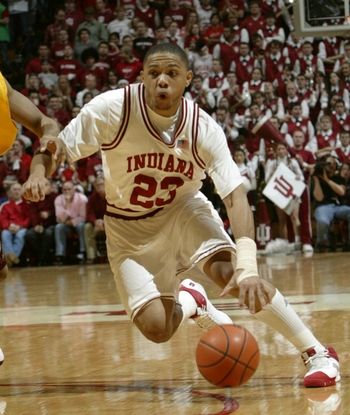
Now:
Many experts predicted Gordon's short stature would limit his ability to finish at the rim at the next level. Yet, this season he finished 59% of his shots around the hoop for a solid 1.24 PPP, which is right on par with last season's 62% shooting and 1.2 PPP at the college level. Once again, Gordon has managed to adapt a key part of his game almost seemingly from college to the NBA, which tells you quite a bit about the talent he possesses.
Many defenders, concerned with Gordon's quick release and deep range, tend to crowd him out past the three-point line, daring him put the ball on the floor. While this defensive approach limits his three-pointer attempts, it gives Gordon the opportunity to use his lethal first step and lateral quickness to blow by his man and attack the rim. This is where Gordon uses his strength and low center of gravity to finish through contact. His body control and finishing ability are also evidenced by his 30 "and-one" finishes this season (T-52nd, NBA). If Gordon can continue to finish this well inside the paint, defenders will have to give him an additional step, which will lead to more open three-point looks.
Part Three: Guard Skills & Decision-Making
Then:
"Gordon doesnt look like a point guard in the least bit at this point in his career, although he may be able to get by in the future playing spot minutes at that position. To do so, he must improve his ball-handling skills, as he often is out of control by the time he gets to the rim due to the lack of control he shows dribbling at high speeds. He doesnt value possessions enough, as evidenced by his 3.4 turnovers per game, as opposed to only 2.5 assists"
- NCAA Weekly Performers, Part Two - 2/14/08
On his NCAA Tournament Performance:
"Neither has his shot selection (improved) either Gordon continued to heave up bowling balls from well beyond the NBA 3-point line (some of which werent even close), even though he obviously needed to get himself easier shots at the rim... Gordon was forcing the issue inside the arc too, settling for tough fade-away jumpers with bigger and longer defenders draped all over him contesting his shot, and he had very little success on those either."
- Bad News for Those Who Didnt Do Their Homework Early... - 3/26/08
Now:
Gordon played the second half of his freshmen season at Indiana hampered by a nagging wrist injury. He showed great toughness playing through the pain, but the injury clearly affected his play, leaving questions regarding his ball-handling skills, court vision, and decision-making abilities unanswered. After an entire NBA season, we've had an opportunity to analyze this portion of Gordon's game and observe his progress towards become a legitimate combo-guard in the League.
It doesn't take much analysis to realize Gordon is clearly a shoot-first player. He's a threat to score at all times, and attacks defenders with a tenacity lacking in most players his age. Yet, there are two sides to this story. Since he's extremely determined to score, Gordon tends to get tunnel vision when he penetrates and rarely makes the easy pass to cutting big men off his drives. His post players are often in a better position to score once interior defenders rotate over to stop his dribble penetration, so he must focus on distributing the basketball more effectively in these half-court situations. This sometimes selfish behavior is exhibited by his 15.0% assist rate (15th among rookies), 2.8 assists per-40 pace adjusted (8th among rookies), and mediocre 1.3 assist-to-turnover ratio. The development of his midrange game could help in this regard since he could be more patient when he beat his man with his quick first step.
With regard to ball-handling, Gordon doesn't possess a spectacular array of moves, and his lack of craftiness in traffic suggests that he's better suited as a shooting guard. On offense, Gordon does a decent job of letting the game come to him, but he must improve his shot-selection off the dribble. He doesn't seem to always understand his limitations on offense, but this can be attributed to his streakiness as a scorer.
With that said, Gordon has managed to cut down on his turnovers substantially transitioning from the NCAA to the NBA, which is an encouraging sign to say the least. He went from averaging an astronomically high 4.1 turnovers per-40 pace adjusted at Indiana to a much more manageable 2.4, and has in the process doubled his mediocre assist to turnover ratio, from .68 to 1.31.
The fact that he plays on the second worst team in the NBA likely has at least something to do with this, though. Over the course of a long and grueling NBA season, the Clippers are the type of team that opponents most look forward to playing, as they sport the leagues worst offense and 5th worst defense. Gordon will need to show next season that he can translate his excellent statistical output to a more competitive environment, and hopefully in the process win more games.
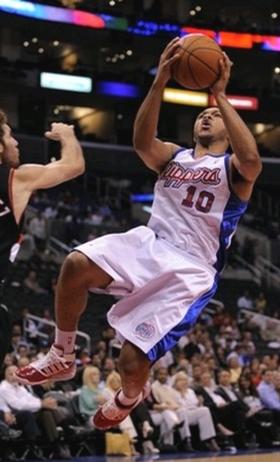
Part Four: Defense
Then:
"Defensively, Gordon shows a great deal of potential, as hes strong, quick and physical, and puts a lot of effort into this part of his game when fully motivated. His low center of gravity helps him stay in front of most any guard he matches up with, and hes quick enough to recover on players even when he gets beat. At times, though, he lacks focus, showing poor fundamentals and letting inferior players get by him. He has good potential in this area, even if many NBA shooting guards will be able to just shoot over him due to his below average size at his position."
- NCAA Weekly Performers, Part Two - 2/14/08
Now:
Gordon, drafted primarily for his offensive talents, has not lived up to his potential as an NBA defender. He still possesses the strength and quickness to become a reliable defensive presence, but playing for the struggling Clippers hasn't allowed him to develop these raw traits into a polished product. Watching Gordon on film, he remains in an upright stance throughout most possessions, relying on his quick hands and explosiveness to create turnovers. His defensive statistics are respectable (1.0 STL/G, 0.5 BLK/G), but he must improve his fundamentals and focus or he could become something of a liability.
In terms of help side defense, Gordon struggles to play within the team-concept. This might be partially due to the fact that the Clippers rank 26th in defensive efficiency rating, giving up 108.8 points per 100 possessions. Yet, Gordon needs to approach the game with a more cerebral mindset, and learn how to make his defensive rotations more efficient, particularly in pick-and-roll situations.
Another inadequacy in Gordon's game is his defensive rebounding abilitieshe ranks as the 4th worst shooting guard in the NBA in that category. By making a more concerted effort to box out someone - even if it's not his man - Gordon will help the Clippers limit second chance points, while giving himself a statistical boost over his very pedestrian 3.0 rebounds per-40 pace adjusted. In a league where most games are decided by a handful of possessions at most, every little bit helps, especially if you play for the Clippers.
Part Five: Intangibles
Then:
"Gordon might not be ready to carry a team right out of the gates as a rookie, as he still lacks some polish and is extremely young and inexperienced--but there are a lot of things to like here, especially his mentality, his versatility as a scorer, and the intangibles he brings to the table, which are reportedly very strong."
- NCAA Weekly Performers, Part Two - 2/14/08
Now:
Eric Gordon's scoring prowess and terrific athleticism are unquestionable, and toward the end of his rookie season, Gordon began to establish himself as a floor leader for his club. His Clippers teammates began feeding him on crucial possessions and trusting him in isolation situations late in games. If he continues to develop his guard skills and defensive awareness and intensity, Gordon could become the backbone of an up-and-coming Clippers team after his rookie contract expires. ESPN's David Thorpe recently summed up Gordon's offensive tenacity very well:
"One of the many things I really like about Gordon right now is that he's not falling in love with his terrific jumper. Especially in late-clock situations. Most guys will count down the seconds and loft a pretty shot, but Gordon is thinking "Attack, attack, attack."
http://sports.espn.go.com/nba/players/rookies/blogs?playerId=3431&season=2009&playerRankingType=1&period=1&set=0&blogSet=0
Eric Gordon is on his way to being quite an NBA player, but still needs to improve his basketball IQ and fundamentals, which will help polish up his skill set and put the finishing touches on a very accomplished NBA combo guard.













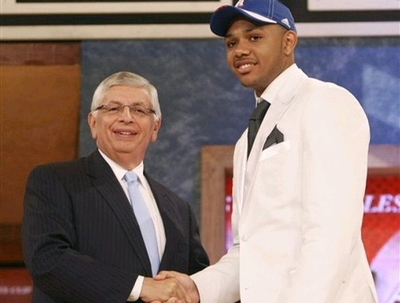

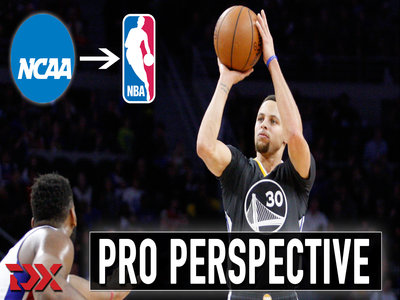
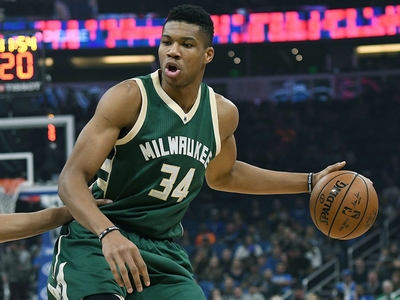










Comments